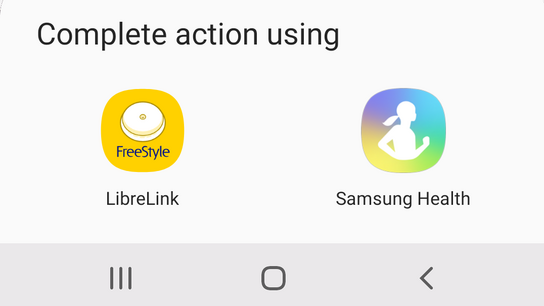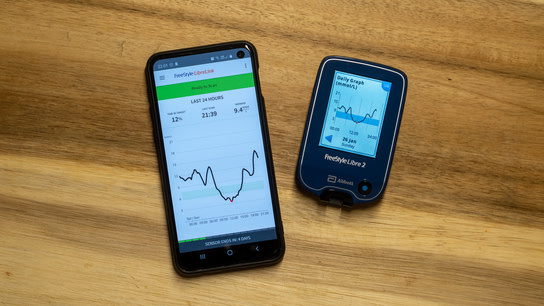I’ve used the FreeStyle Libre 2 (“FreeStyle Libre 14-days” in some regions) flash glucose monitoring system for a year. The system can get up to eight hours of glucose readings by scanning an NFC sensor installed on the back of your upper arm. I’ve previously shared my experiences on what it’s like to wear the sensor (with photos of the Libre Sensor.)
I want to discuss the pros and cons of using the dedicated FreeStyle Libre 2 Reader device versus an NFC-capable smartphone. The Reader has a big NFC antenna and can easily pick up the signal from the sensor. Some phones have tiny short-range NFC antennas that make scanning the sensor a pain. Your experiences using either device should be similar assuming your phone has an okay NFC-antenna.
You need to install the FreeStyle LibreLink app (Android or iOS versions available) to scan the FreeStyle Libre Sensor. Abbott ships different versions of the app in different regions to comply with different regulatory requirements. I’ve been using the Norwegian edition of the Android version of the LibreLink app. Your experience and feature availability in other regions may vary wildly.
Both the reader and LibreLink app give you glucose level trends along with your current glucose level. You also get historical graphs and daily averages. My one big complaint about the app is that you can’t zoom and pan the graphs. It feels natural to do so but it’s not supported. This limitation is more understandable on the less capable Reader. The app is well designed compared to something like the Contour Diabetes app.
Both your smartphone and Reader can also receive glucose level alerts over Bluetooth transmitted by the Sensor. This has some potential privacy implications but can be a literal life-saver and help you better maintain your glucose levels.
I sleep better at night knowing it will set off an alarm if my glucose levels dip to critical levels while I sleep. It may admittedly be a bit annoying to be woken up to deal with high glucose levels. However, I’ll feel better the next day having corrected high levels early than if I’d gotten a bit more sleep with the high levels.
That being said, the critical level alarms aren’t completely reliable. You can enable an option in the Reader or app that will alert you every time they lose contact with the Sensor. You don’t want this option enabled! It goes off all the time even when your phone or the Reader is less than a meter apart.
It can sometimes take up to an hour after glucose levels have left the target range before the alarm triggers. Both the app and Reader will annoyingly trigger the alarm even if you just scanned and got a low or high reading less than 20 seconds earlier.
The alarms don’t go off if you’ve set your phone to silent or do-not-disturb mode. Your phone may automatically enable silent mode at night to help ensure you get fewer notifications and more sleep. You may be able to configure the alerts from the LibreLink app as critical. Depending on your phone model and settings, this may let the app bypass silent mode.
This limitation is probably the best reason to use the Reader instead of the app. You can technically silence the alarms on the Reader too, but you’d never venture into the menus to turn it off as you might do with your smartphone. You can’t accidentally silence it by holding the volume down button pressed for five seconds like you can on Android, either.
Update (): LibreLink version 2.4.0 for Android includes a work-around for triggering alarms when the device is in do-not-disturb mode. However, it isn’t enabled by default and it requires you to dig deep into system settings. It also doesn’t work if the phone is set to silent mode.
On Android, you may run into problems if you’ve got other NFC-capable apps installed on your phone. For example, the Samsung Health app will conflict with the LibreLink app. You’ll get the dialog shown below every time you scan the sensor.

Android dialog prompts for which NFC-capable app to use.
You can’t see the dialog when you hold it up to the back of your arm, however. You need to look at the phone, choose the LibreLink app, and then rescan your sensor. Opening the LibreLink app before you scan the Sensor sometimes skips the dialog but not every time.
You’ll need to uninstall other NFC-capable apps to work around this problem if you’re not really motivated to deal with the dialog.
The Reader is easier to use because you just turn it on and hold it up to the sensor. The NFC antenna is located at the top of the reader. This design makes it slightly easier to use compared to most phones that place the antenna at the center-back.
The main reason you’d want to ditch the Reader in favor of just using your phone is that it’s impractical to carry multiple devices. My insulin pump, phone, keys, and wallet already take up all the space in my pockets.
I wrote the following in an early draft of this article: “using my phone for scanning is a disaster waiting to happen”. A month ago, I dropped my phone while trying to scan the sensor. I was wearing a winter jacket and the sensor and I had to stretch my arm a bit awkwardly to scan it. (Low glucose levels didn’t help the situation.) The phone landed display-first on a pebble, and I ended up having to replace it.
The reader device is about 75 Euros and is far cheaper to replace if you drop it compared to a smartphone! The technical specifications for the Reader say its expected lifetime is three years.
The Reader weighs just 65 grams. It’s so much lighter than I expect so I’ve thrown it across the room a couple of times when I’ve picked it up from the table. I just expect it to be heavier.
Abbott promises “up to 7-day battery” on the Reader. In my experience, it only lasts two–three days. Engineering schematics of the Reader shows there is room for a higher capacity battery. I wish Abbott had decided to not cheap out on the battery capacity.
The LibreLink app can send your glucose readings to lets you share readings with “up to 20 people” who install the FreeStyle LibreLinkUp app and link it to your LibreLink app. Availability varies by country.
I’ve written this comparison from the perspective that you must make a choice between either the LibreLink app or the Reader. However, you can use both at the same time with the same Sensor!
If you activate a Libre Sensor with the Reader, you can then also read from it with the LibreLink app. Only the Reader will receive notifications, however. You notably can’t use the Reader if you’ve activated the Sensor using the app. (This limitation makes no sense to me!)
You can even scan the Sensor with multiple paired LibreLink apps if you’ve got multiple smartphones or tablets. This turned out to be useful when I trashed my phone and needed to replace it. I didn’t need to replace the Sensor to pair it with the new phone. It can also be useful for anyone who has one or more guardians or partners that want to (mostly unobtrusively) take their glucose readings.
The Reader and app doesn’t sync data between each other, however. Neither does the LibreLink app between different devices even when you’ve logged in to the same account. You need to scan with both devices every 8-hours to maintain the graphs and trend data.
I tend to leave the Reader at home and bring it into the bedroom at night. As discussed earlier, the app isn’t as reliable as the Reader when it comes to delivering alerts. I can still scan my glucose levels using my phone when I’m out and about. I clearly didn’t learn from dropping my phone while scanning on the go. I don’t need to bring the Reader with me everywhere I go, at least.
Update (): I haven’t used the FreeStyle Reader for the last year. I don’t miss it and I get by fine using just the LibreLink app on my Android smartphone.
I’m happy with the FreeStyle Libre system overall. It could be better and there is plenty of room for improvement. However, it’s a huge improvement over doing multiple finger-prick blood tests every day.
